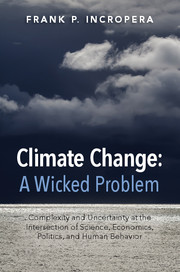 Climate Change: A Wicked Problem
Climate Change: A Wicked Problem Published online by Cambridge University Press: 05 October 2015
In situ, natural gas is a mixture consisting largely of methane, CH4 (70–90% by volume); smaller amounts of ethane, C2H6, propane, C3H8, butane, C4H10, pentane, C5H12, and/or hexane, C6H14 (0–20%); carbon dioxide, CO2 (0–8%); and trace amounts of other gases such as hydrogen sulfide, H2S. As the pressure and temperature of the gas decrease during extraction from a well, pentane and hexane condense to their liquid states and separate from the gas. At the wellhead, CO2 is removed, as is H2S, which is both toxic and corrosive. The remaining gas can then be compressed and routed to a pipeline, or it can be liquefied at a temperature of –162 °C (– 260°F)to increase its energy content per unit volume, facilitating transport as liquefied natural gas (LNG).
As late as 2006, conventional wisdom was that U.S. production of natural gas was in decline, with increasing imports needed to meet demand. But perceptions began to change with the discovery and exploitation of large gas-bearing shales, beginning with the Barnett Shale in Northeast Texas. Just two years later, with the discovery of the Marcellus Shale extending southwest from upstate New York through Appalachia, as well as the Haynesville (Louisiana), Fayetteville (Arkansas), Woodford-Arkoma (Arkansas and Oklahoma), and Bakken (North Dakota and Montana) shales, there was growing belief that the nation would soon be awash in natural gas and its reserves-to-production ratio would exceed 100 years (Krauss, 2008a, 2008b).
Conventional gas is extracted primarily from porous sandstone lying below impermeable cap rock. The large permeability of the sandstone makes it easy to extract the gas once a well has been drilled. That's not the case for unconventional gas found in coal seams, tight sands, and shale rock. The low permeability of these formations limits gas production by conventional means.
Shale is a soft, fine-grained rock formed from mud deposits in shallow seas some 400 million years ago. Although shale formations are buried up to 4,000 meters below ground and gas is trapped within the shale, advanced recovery techniques have made production economically viable. A well can be drilled to the requisite depth and extended horizontally for thousands of meters, thereby greatly expanding the size of a gas field accessible to a single well.
To save this book to your Kindle, first ensure [email protected] is added to your Approved Personal Document E-mail List under your Personal Document Settings on the Manage Your Content and Devices page of your Amazon account. Then enter the ‘name’ part of your Kindle email address below. Find out more about saving to your Kindle.
Note you can select to save to either the @free.kindle.com or @kindle.com variations. ‘@free.kindle.com’ emails are free but can only be saved to your device when it is connected to wi-fi. ‘@kindle.com’ emails can be delivered even when you are not connected to wi-fi, but note that service fees apply.
Find out more about the Kindle Personal Document Service.
To save content items to your account, please confirm that you agree to abide by our usage policies. If this is the first time you use this feature, you will be asked to authorise Cambridge Core to connect with your account. Find out more about saving content to Dropbox.
To save content items to your account, please confirm that you agree to abide by our usage policies. If this is the first time you use this feature, you will be asked to authorise Cambridge Core to connect with your account. Find out more about saving content to Google Drive.